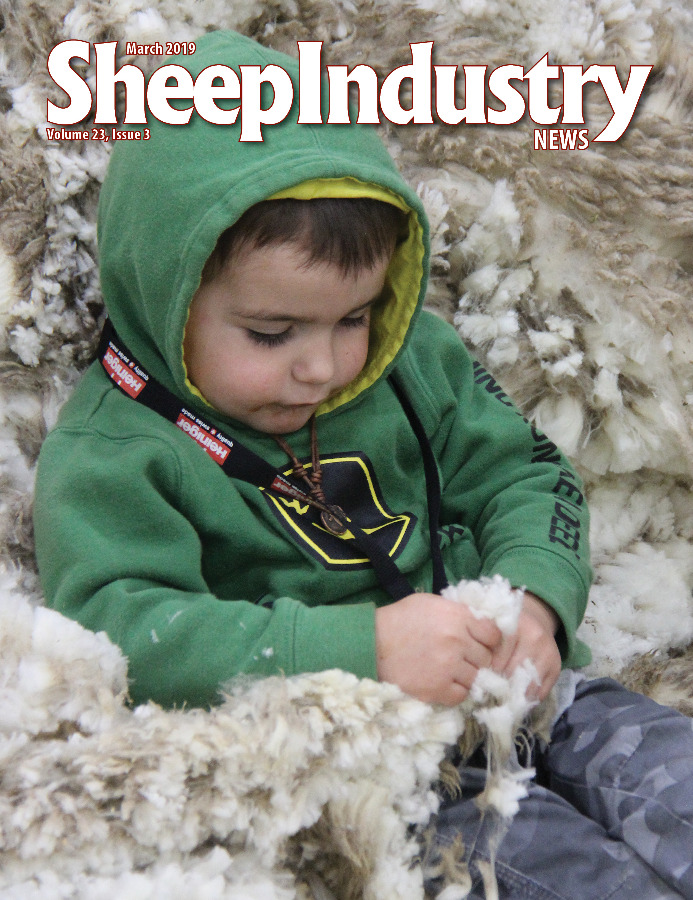
- March 2019
- President’s Notes
- Perrin Edges Shearing Field
- Guest Opinion Shearer Teaches Tips, Tricks
- Convention: Annual Convention Carries Industry Into New Year
- Convention: Award Winners Accept Well-Deserved Honors
- Convention: AWC Wants Consumers to Experience American Wool
- Convention: YE’s Prove Competitive & Determined
- Convention: Lamb Council Examines Technology
- Convention: Monitoring Fake Meat
- Convention: Stakeholders Look to Harness Data
- Convention: Managing Parasites in an Age of Drug Resistance
- Convention: Resource Mgt. Take Aim at 2019 Goals
- Convention: Fungus is Coming
- Convention: Producers, Fishermen Share Common Problems
- Convention: Make It With Wool Fashion Show
- Market Report
- Around the States
- The Last Word
Genetic Stakeholders Look for Ways to Harness Data
CAT URBIGKIT
The Shepherd
We live in the information age, Utah producer Tom Boyer told participants in the Genetic Stakeholders meeting at the ASI Annual Convention, but that alone won’t solve our problems.
“Data is everywhere … but bringing all that data together is somewhat of a challenge,” he added.
Dr. Jessica Petersen and Dr. Ron Lewis of the University of Nebraska–Lincoln gave an update on current genomics research, an extension of a project that began with the Let’s Grow genotyping study.
DNA testing in sheep is used to verify parentage, as well as help screen for undesirable traits, while genomics testing is used to develop genomic predictions and enhanced breeding values.
Petersen explained that genomics research involves three levels of analysis of genetic markers (DNA sequences with known locations on a chromosome) associated with:
• Individual traits – looking for single markers, such as those associated with Spider Lamb Syndrome, OPP and scrapie susceptibilities, and myostatin (double-muscling);
• Parentage panels – looking at hundreds of markers for parental lineages;
• Genotyping Arrays – gathers info at thousands of markers spread across the genome, helping to identify key genes responsible for desired measured traits such as high fertility, efficient feed conversion, etc.
Genomics allows researchers to go beyond parentage to refine relationships, and allows for statistical association of genetic variation with a phenotype. Research clearly revealed that Merino sheep are a different breed than Rambouillet, and Rambouillets from both Europe and the United States had substantial overlap.
Similarly, Irish and American Suffolks grouped together, with Australian Suffolks demonstrating a marked difference.
Petersen explained that the current project genotyped 64 animals from each of the three sheep breeds: Katahdin, Rambouillet and Suffolk. Priority was given to rams with performance records and with five or more offspring with NSIP records. While 88 percent of the markers were variable, genotyping did clearly distinguish between the breeds.
The same region of each breed proved differences, as well. These regions are associated with the production of wool versus hair, thus the differences between Rambouillet (wool sheep) and Katahdin (hair sheep) reflected differences at the chromosomal level.
The advancement of sheep genomics will allow the sheep industry to build genome-enhanced breeding values, which allows earlier predictions of an animal’s merit, and the acceleration of genetic progress.
Petersen noted there are challenges toward this progress:
• Predictions are not accurate when applied across breeds, so we need data on American animals, and to keep taking data on our animals;
• While opportunities for genetic improvement exist, genomics testing needs to be a cost-effective tool.
Petersen said she anticipates that within a few years, genomics testing will be cost-effective for producers, so collecting samples and data now will provide benefits in the future.
Triplet Lamb Effects
While increasing prolificacy has been proposed as an effective way to increase efficiency and profitability, that increased prolificacy may not be sustainable or desirable in some production systems, according to Dr. Dave Notter.
“We have tools for increasing prolificacy, but those increases must be maintained and realized through weaning,” Notter said, citing collaborative research with the U.S. Sheep Experiment Station in Dubois, Idaho.
Three experiments were conducted:
Experiment 1: Half the Polypay ewes that produced triplets had to rear them all, while half had their litters reduced to two lambs.
Experiment 2: Experiment Station Polypay rams mated to industry Polypays: all ewes that produced triplets had to rear their lambs.
Experiment 3: Polypay and one-quarter Romanov ewes; all ewes that produced triplets had to rear their lambs.
For the Polypays in the study, the average number of lambs born to the adult (2-5 year old) ewes was 2.4 lambs. Litter sizes peaked when the ewes were 5 years old.
Ewes that raised their triplets weaned more lambs and had more body weight of lambs than the ewes that had triplet litters reduced to two. Ewes that raised their triplets also weaned more lambs than ewes that had twins. However, neither group of triplet-bearing ewes weaned more body weight of lambs than ewes that had twins.
Based on these three experiments, ewes that were required to rear triplet lambs weaned 0.20 more lambs per litter than ewes that had twins, but also had 0.75 additional dead lambs per litter, and thus a lamb mortality overhead of 3.75 additional dead lambs for each additional weaned lamb.
Notter suggested there is an intermediate optimum prolificacy level, and that if the optimum prolificacy is exceeded, removal and artificial rearing of surplus lambs is necessary to avoid increased lamb death losses.
Notter emphasized the importance of the work of Dr. J. Bret Taylor and the U.S. Sheep Experiment Station, but noted Taylor was unable to attend the ASI convention due to the federal government shutdown.

